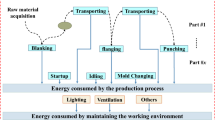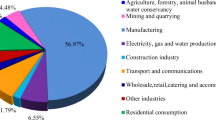Abstract
Parts or products can be considered as the carrier of energy consumption during manufacturing since they are the final output of workshops. The concept of “embodied energy” is presented as a feasible indicator to characterize the energy consumption of a part or a product. Previous work mainly discussed methods and technologies to apply the embodied energy of parts for selecting materials and processes in product design; the role that embodied energy of parts can play in production optimization was seldom investigated. In addition, different from machining workshops, which has been widely discussed, there is less research on energy saving in the sheet metal forming workshop. In this paper, modeling and application of embodied energy for energy saving in the sheet metal forming workshop is presented. The embodied energy of parts during the manufacturing phase (EEPM) is modeled. The EEPM is evaluated by discrete event simulation to identify energy distribution, energy-intensive processes, and bottlenecks (e.g., processes with feed blocking, machines with low utilization, and others) during production. Energy-oriented scheduling in the workshop is implemented, and a two-stage approach based on ranks of EEPM that can quickly select more efficient production solutions is proposed. A case in a stamping workshop of a partner company validates the proposed methods. This study provides a practical approach to seek a trade-off between energy saving and high production efficiency for energy-intensive discrete workshops.










Similar content being viewed by others
Data availability
All data needed to evaluate the conclusions in the paper are present in the paper. Additional data related to this paper are available from the corresponding authors upon reasonable requests.
References
BP Amoco (2019) BP Statistical Review of World Energy. https://www.bp.com/zh_cn/china/home/news/reports/statistical-review-2019.html. Accessed 10 Oct 2019
U.S. Energy Information Administration (2019) International energy outlook 2019. https://www.eia.gov/outlooks/ieo/. Accessed 15 Oct 2019
Gao MD, He K, Li L, Wang QY, Liu CH (2019) A review on energy consumption, energy efficiency and energy saving of metal forming processes from different hierarchies. Process 7:357. https://doi.org/10.3390/pr7060357
Abdel-Baqi OJ, Nasiri A, Miller PJ (2016) Energy Management for an 8000 hp Hybrid Hydraulic Mining Shovel. IEEE Trans Ind Appl 52:5041–5050. https://doi.org/10.1109/TIA.2016.2599857
Huang HH, Jin R, Li L, Liu ZF (2018) Improving the energy efficiency of a hydraulic press via variable-speed variable-displacement pump unit. J Dyn Syst Meas Control-Trans ASME 140:111006. https://doi.org/10.1115/1.4040325
Li L, Huang HH, Zhao F, Triebe M, Liu ZF (2017) Analysis of a novel energy-efficient system with double-actuator for hydraulic press. Mechatronics 47:77–87. https://doi.org/10.1016/j.mechatronics.2017.08.012
Schenke C, Weber J (2019) Energy efficiency of displacement control drive systems in hydraulic forming presses. J Manuf Sci Eng 141:041013. https://doi.org/10.1115/1.4042604
Landgrebe D, Kräusel V, Rautenstrauch A, Albert A, Wertheim R (2016) Energy-efficiency in a hybrid process of sheet metal forming and polymer injection moulding. Procedia CIRP 40:109–114. https://doi.org/10.1016/j.procir.2016.01.068
Li L, Huang HH, Zhao F, Zou X, Mendis G, Luan XN, Liu ZF, Sutherland JW (2019) Modeling and analysis of the process energy for cylindrical drawing. J Manuf Sci Eng 141:021001. https://doi.org/10.1115/1.4041924
Li L, Huang HH, Zhao F, Zou X, Lu Q, Wang Y, Liu ZF, Sutherland JW (2019) Variations of energy demand with process parameters in cylindrical drawing of stainless steel. J Manuf Sci Eng 141:091002. https://doi.org/10.1115/1.4043982
Xiao WC, Wang BY, Zhou J, Ma WY, Yang L (2016) Optimization of aluminum sheet hot stamping process using a multi-objective stochastic approach. Eng Optim 48:2173–2189. https://doi.org/10.1080/0305215X.2016.1163483
Clayton T (2019) Value-added and non-value added process steps. https://service.asu.edu/blog/value-added-and-non-value-added-process-steps. Accessed 22 Sep 2019
Seow YY (2011) A framework for modelling embodied product energy to support energy efficient manufacturing. Ph.D. Degree. Loughborough University, Loughborough, UK
Rahimifard S, Seow YY, Childs T (2010) Minimising Embodied Product Energy to support energy efficient manufacturing. CIRP Ann-Manuf Technol 59:25–28. https://doi.org/10.1016/j.cirp.2010.03.048
Costanza R (1980) Embodied energy and economic valuation. Science 210:1219–1224. https://doi.org/10.1126/science.210.4475.1219
Salcido J, Raheem A, Ravi S (2016) Comparison of embodied energy and environmental impact of alternative materials used in reticulated dome construction. Build Environ 96:22–34. https://doi.org/10.1016/j.buildenv.2015.11.010
Chen B, Li JS, Wu XF, Han MY, Zeng L, Li Z, Chen GQ (2018) Global energy flows embodied in international trade: a combination of environmentally extended input–output analysis and complex network analysis. Appl Energy 210:98–107. https://doi.org/10.1016/j.apenergy.2017.10.113
Sheppard P, Rahimifard S (2019) Embodied energy in preventable food manufacturing waste in the United Kingdom. Resour Conserv Recycl 146:549–559. https://doi.org/10.1016/j.resconrec.2019.03.002
Feng ZJ, Zhou W, Ming Q (2019) Embodied energy flow patterns of the internal and external industries of manufacturing in China. Sustainability 11:438. https://doi.org/10.3390/su11020438
Kara S, Manmek S, Herrmann C (2010) Global manufacturing and the embodied energy of products. CIRP Ann-Manuf Technol 5:29–32. https://doi.org/10.1016/j.cirp.2010.03.004
Kara S, Ibbotson S (2011) Embodied energy of manufacturing supply chains. CIRP J Manuf Sci and Technol 4:317–323. https://doi.org/10.1016/j.cirpj.2011.03.006
Seow YY, Goffin N, Rahimifard S, Woolley E (2016) A ‘Design for Energy Minimization’ approach to reduce energy consumption during the manufacturing phase. Energy 109:894–905. https://doi.org/10.1016/j.energy.2016.05.099
Shao L, Chen GQ (2016) Renewability assessment of a production system: based on embodied energy as emergy. Renew Sust Energ Rev 57:380–392. https://doi.org/10.1016/j.rser.2015.12.063
Liu Z, Guo Y, Cao HJ, Zhao G, Liu Z (2017) Embodied energy in dry cutting under consumption of tool and materials. Procedia CIRP 6:535–540. https://doi.org/10.1016/j.procir.2016.11.207
Zanoletti A, Federici S, Borgese L, Bergese P, Ferroni M, Depero L, Bontempi E (2017) Embodied energy as key parameter for sustainable materials selection: the case of reusing coal fly ash for removing anionic surfactants. J Clean Prod 141:230–236. https://doi.org/10.1016/j.jclepro.2016.09.070
Ozoemena M, Cheung W, Hasan R (2018) Improving uncertainty analysis of embodied energy and embodied carbon in wind turbine design. Int J Adv Manuf Technol 94:1565–1577. https://doi.org/10.1007/s00170-016-9972-7
Morini A, Ribeiro M, Hotza D (2019) Early-stage materials selection based on embodied energy and carbon footprint. Mater Des 178:107861. https://doi.org/10.1016/j.matdes.2019.107861
Yacob P, Wong LS, Khor SC (2019) An empirical investigation of green initiatives and environmental sustainability for manufacturing SMEs. J Manuf Technol Manag 30:2–25. https://doi.org/10.1108/JMTM-08-2017-0153
Schmidt C, Li W, Thiede S, Kara S, Herrmann C (2015) A methodology for customized prediction of energy consumption in manufacturing industries. Int J Precis Eng Manuf-Green Technol 2:163–172. https://doi.org/10.1007/s40684-015-0021-z
Wang QL, Wang XL, Yang SH (2014) Energy consumption modelling of the machining system based on Petri net. Adv Mech Eng 6:324819. https://doi.org/10.1155/2014/324819
Li HC, Li H, Yang HD, Yang BX, Zhu CJ, Yin SH (2017) Modelling and simulation of energy consumption of ceramic production chains with mixed flows using hybrid Petri nets. Int J Pro Res 56:3007–3024. https://doi.org/10.1080/00207543.2017.1391415
Mawson V, Hughes B (2019) The development of modelling tools to improve energy efficiency in manufacturing processes and systems. J Manuf Syst 51:95–105. https://doi.org/10.1016/j.jmsy.2019.04.008
Lin WW, Yu DY, Zhang CY, Liu X, Zhang SQ, Tian YH, Liu SQ, Xie ZP (2015) A multi-objective teaching-learning-based optimization algorithm to scheduling in turning processes for minimizing makespan and carbon footprint. J Clean Prod 101:337–347. https://doi.org/10.1016/j.jclepro.2015.03.099
May G, Stahl B, Taisch M, Prabhu V (2015) Multi-objective genetic algorithm for energy-efficient job shop scheduling. Int J Prod Res 53:7071–7089. https://doi.org/10.1080/00207543.2015.1005248
Lu C, Gao L, Li XY, Pan QK, Wang Q (2017) Energy-efficient permutation flow shop scheduling problem using a hybrid multi-objective backtracking search algorithm. J Clean Prod 144:228–238. https://doi.org/10.1016/j.jclepro.2017.01.011
Zhang H, Zhao F, Sutherland JW (2017) Scheduling of a single flow shop for minimal energy cost under real-time electricity pricing. J Manuf Sci Eng 139:014502. https://doi.org/10.1115/1.4034275
Baykasoğlu A, Ozsoydan F (2018) Dynamic scheduling of parallel heat treatment furnaces: a case study at a manufacturing system. J Manuf Syst 46:152–162. https://doi.org/10.1016/j.jmsy.2017.12.005
Yu T, Zhu C, Chang Q, Wang JF (2019) Imperfect corrective maintenance scheduling for energy efficient manufacturing systems through online task allocation method. J Manuf Syst 53:282–290. https://doi.org/10.1016/j.jmsy.2019.11.002
Li YF, He Y, Wang YL, Tao F, Sutherland JW (2020) An optimization method for energy-conscious production in flexible machining job shops with dynamic job arrivals and machine breakdowns. J Clean Prod 254:120009. https://doi.org/10.1016/j.jclepro.2020.120009
Wang S, Lu X, Li XX, Li WD (2015) A systematic approach of process planning and scheduling optimization for sustainable machining. J Clean Prod 87:914–929. https://doi.org/10.1016/j.jclepro.2014.10.008
Yan JH, Li L, Zhao F, Zhang FY, Zhao QL (2016) A multi-level optimization approach for energy-efficient flexible flow shop scheduling. J Clean Prod 137:1543–1552. https://doi.org/10.1016/j.jclepro.2016.06.161
Koltsaklis N, Giannakakis M, Georgiadis M (2018) Optimal energy planning and scheduling of microgrids. Chem Eng Res Des 131:318–323. https://doi.org/10.1016/j.cherd.2017.07.030
Li L, Huang HH, Liu ZF, Li X, Triebe MJ, Zhao F (2016) An energy-saving method to solve the mismatch between installed and demanded power in hydraulic press. J Clean Prod 139:636–645. https://doi.org/10.1016/j.jclepro.2016.08.063
Liu Q, Tian YQ, Wang C, Chekem FO, Sutherland JW (2018) Flexible job-shop scheduling for reduced manufacturing carbon footprint. J Manuf Sci Eng 140:0601006. https://doi.org/10.1115/1.4037710
Bhatt N, Chauhan N (2015) Genetic algorithm applications on job shop scheduling problem: a review. 2015 Int Conf Soft Comput Tech Implement. Faridabad, India: 7-14. https://doi.org/10.1109/ICSCTI.2015.7489556.
Deb K, Pratap A, Agrawal S, Meyarivan T (2002) A fast and elitist multiobjective genetic algorithm: NSGA-II. IEEE Trans Evol Comput 6:182–197. https://doi.org/10.1109/4235.996017
Funding
This work was supported by the National Natural Science Foundation of China (grant number U20A20295) and the Natural Science Foundation of Anhui Province (grant number 2008085QE265).
Author information
Authors and Affiliations
Contributions
Wei Xiong designed and drafted the manuscript, Haihong Huang conceived the project and organized the paper, Lei Li designed the verification method, Lei Gan performed the experiments and recorded the data, Libin Zhu and Mengdi Gao analyzed the data, and Zhifeng Liu contributed to overall evaluation and revised the paper. All authors read and approved the manuscript.
Corresponding author
Ethics declarations
Ethical approval
Not applicable.
Consent to participate
All the participated persons are listed in the article or acknowledged in the paper.
Consent to publish
The authors consent to transfer the copyright of the article to publish.
Conflicts of interest
The authors declare no competing interests.
Additional information
Publisher’s note
Springer Nature remains neutral with regard to jurisdictional claims in published maps and institutional affiliations.
Rights and permissions
About this article
Cite this article
Xiong, W., Huang, H., Li, L. et al. Embodied energy of parts in sheet metal forming: modeling and application for energy saving in the workshop. Int J Adv Manuf Technol 118, 3933–3948 (2022). https://doi.org/10.1007/s00170-021-08209-6
Received:
Accepted:
Published:
Issue Date:
DOI: https://doi.org/10.1007/s00170-021-08209-6




